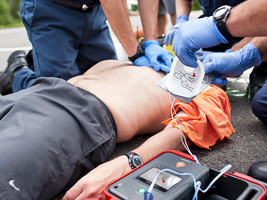When every second counts
Posted by First Responder Systems on 2nd May 2021
When seconds count. Imagine you are out with a friend. Everything is normal, just a regular day. Suddenly, your friend collapses. You kneel down by their side and gently shake them, calling their name. They do not respond. You notice they are not breathing normally or maybe not at all. Their heart has stopped beating effectively. They are unresponsive. Death will occur in minutes if someone doesn’t help, NOW! Do you know what to do?
This scenario happens more than 800 times every DAY in the United States. Sudden cardiac arrest (SCA) is a leading cause of death for men and women. Sudden cardiac arrest occurs suddenly and often without warning. It is triggered by an electrical malfunction in the heart that causes an irregular heartbeat known as an arrhythmia. The most common arrhythmia in SCA is Ventricular Fibrillation. With its pumping action disrupted, the heart cannot pump blood to the brain, lungs and other organs. Seconds later, a person loses consciousness and has no pulse. Death occurs within minutes if the victim does not receive treatment.
How do you treat SCA? First, learn Cardiopulmonary Resuscitation (CPR). High quality CPR buys time until further treatment can be administered. However, CPR is only about 40% as effective as the victim’s native heart beat. A normal heart beat must be restored quickly. We do not have time to wait for the paramedics and EMT’s to arrive. It will most likely be too late. Next, grab the closest Automated External Defibrillator (AED), turn it on and follow the voice prompts.
AEDs are portable electronic devices that automatically detect the life-threatening cardiac arrhythmias of ventricular fibrillation and ventricular tachycardia. Once detected the AED will charge and allow the user to press the shock button to deliver a therapeutic electrical shock to the victim. The goal is to reverse the cardiac arrhythmia and restore a normal heart beat. The faster we terminate the lethal arrhythmias, the better the outcome for the patient.
AEDs are available for home use, offices, any worksite, recreational facilities, places of worship and anywhere people live, work or play. Take the steps to create an AED program. Need help getting started? Give us a call and our trained healthcare providers will assist you step by step.

